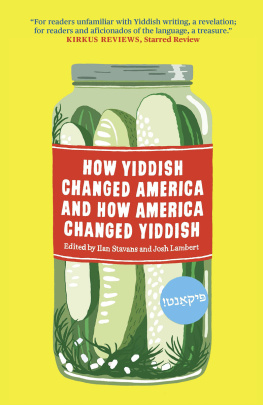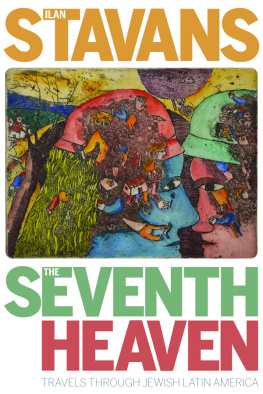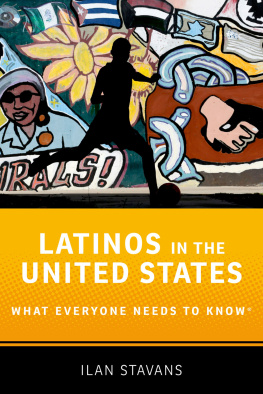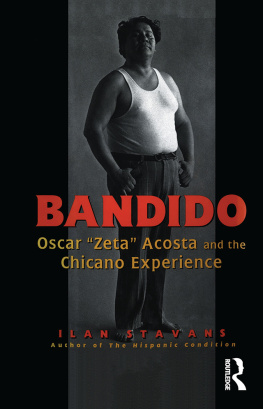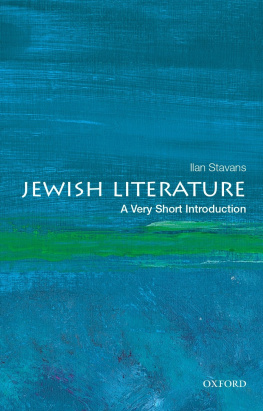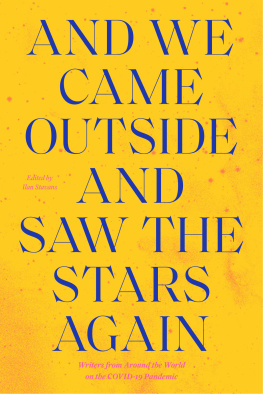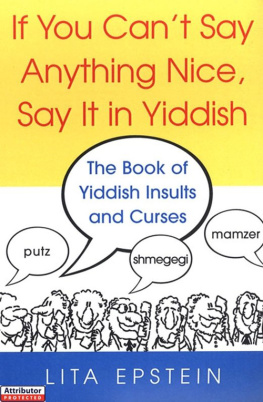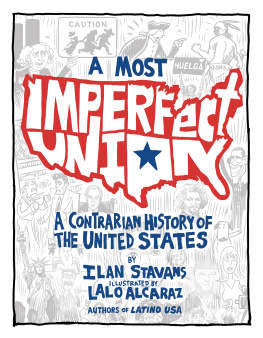Ilan Stavans (editor) - How Yiddish changed America and how America changed Yiddish
Here you can read online Ilan Stavans (editor) - How Yiddish changed America and how America changed Yiddish full text of the book (entire story) in english for free. Download pdf and epub, get meaning, cover and reviews about this ebook. year: 2020, genre: Detective and thriller. Description of the work, (preface) as well as reviews are available. Best literature library LitArk.com created for fans of good reading and offers a wide selection of genres:
Romance novel
Science fiction
Adventure
Detective
Science
History
Home and family
Prose
Art
Politics
Computer
Non-fiction
Religion
Business
Children
Humor
Choose a favorite category and find really read worthwhile books. Enjoy immersion in the world of imagination, feel the emotions of the characters or learn something new for yourself, make an fascinating discovery.
- Book:How Yiddish changed America and how America changed Yiddish
- Author:
- Genre:
- Year:2020
- Rating:3 / 5
- Favourites:Add to favourites
- Your mark:
- 60
- 1
- 2
- 3
- 4
- 5
How Yiddish changed America and how America changed Yiddish: summary, description and annotation
We offer to read an annotation, description, summary or preface (depends on what the author of the book "How Yiddish changed America and how America changed Yiddish" wrote himself). If you haven't found the necessary information about the book — write in the comments, we will try to find it.
How Yiddish changed America and how America changed Yiddish — read online for free the complete book (whole text) full work
Below is the text of the book, divided by pages. System saving the place of the last page read, allows you to conveniently read the book "How Yiddish changed America and how America changed Yiddish" online for free, without having to search again every time where you left off. Put a bookmark, and you can go to the page where you finished reading at any time.
Font size:
Interval:
Bookmark:



This work is published with support from the Yiddish Book Center, thanks to a gift from Lori and Michael Gilman;
David Bruce Smith, Grateful American Foundation;
And Terry Philip Segal.
To my Tate-Mame .
I.S.
To my mitarbeters at the Yiddish Book Center, all those who came before us, and the supporters who helped to make it the institution it is today.
J.L.
- Ilan Stavans and Josh Lambert
- Abraham Cahan fiction
- Irving Howe essay
- Yeshaye Katovski, translated by Eddy Portnoy letter
- Emma Goldman speech
- William Gropper cartoons
- Daniel Kahn, adapted by Mordechai Gebirtig poem
- Paul Buhle essay
- Bernard Weinstein, translated by Maurice Wolfthal essay
- Morris Rosenfeld, translated by Leon Stein poem
- Sholem Asch, t ranslated by Joachim Neugroschel play
- Eddy Portnoy essay
- LOLA cartoon
- Naomi Seidman essay
- Aaron Lansky and Gitl Schaechter-Viswanath dialogue
- Jeffrey Shandler essay
- Ilan Stavans essay
- Shirley Kumove wordplay
- Stanley Siegelman poem
- Matthew Goodman essay
- Aaron Lansky memoir
- Arthur Klein, Alice Ahart, Lisa Newman, Albert Berkowitz, Daniel Okrent memories
- Kadya Molodowsky, translated by Miriam Udel fiction
- Asya Vaisman Schulman lexicon
- Procter & Gamble recipes
- A lison Sparks recipes
- Isadore Lillian, t ranslated by Jane Peppler song
- Isaac Bashevis Singer, translated by Dorothea Straus fiction
- Isaac Bashevis Singer essay
- Janet Hadda, Kenneth Turan, Anita Norich, Aaron Lansky, Ilan Stavans, Rivka Galchen appreciation
- Anna Margolin, translated by Maia Evrona and Shirley Kumove poems
- I Will Run Away, You Beam, Im Beaming, and White as the Snow on the Alps
- Celia Dropkin, translated by Gene Zeiger and Maia Evrona poems
- Jacob Glatstein, translated by Maier Deshell fiction
- Moyshe-Leyb Halpern, translated by Aaron Rubinstein poem
- Peretz Hirschbein, translated by Jessica Kirzane memoir
- Blume Lempel, translated by Ellen Cassedy and Yermiyahu Ahron Taub fiction
- Rokhl Korn, translated by Seymour Levitan fiction
- Chaim Grade, translated by Barnett Zumoff poem
- Victor Packer, translated by Henry Sapoznik poem
- Moyshe Nadir, translated by Michael Shapiro play
- Lamed Shapiro, translated by Heather Valencia fiction
- Joseph Opatoshu, translated by Shulamith Berger fiction
- David Frischmann, translated by Binyomin Weiner parody
- Malka Heifetz-Tussman, translated by Jack Hirschman poem
- Grace Paley fiction
- Cynthia Ozick essay
- Art Spiegelman cartoon
- Ilan Stavans essay
- Sophie Tucker, translated by Adah Hetko song
- Paula Vogel and Victoria Myers dialogue
- Fyvush Finkel, Walter Matthau, Alan Alda, Elliott Gould, Alan King, JERRY STILLER, Joan Micklin Silver, Leonard Nimoy oral history
- Liana Finck cartoon
- Anonymous parody
- Irena Klepfisz poem
- Michael Chabon fiction
- Steve Stern and Andrew Furman dialogue
- Stan Mack cartoon
- Ruth Behar memoir
- Joseph Goodman, translated by Hannah Berliner Fischthal essay
- Isaac Berliner, translated by Ilan Stavans poem
- Goldie Morgentaler essay
- Claudia Mirelstein, translated by Bernard Levinson fiction
- Ilan Stavans memoir
- Alberto Gerchunoff, translated by Prudencio de Pereda vignette
We have to believe in free will. We have no choice.
Isaac Bashevis Singer
Celebrated and marginalized, lionized and trivialized, Yiddish is so deeply woven into the fabric of the United States that it can sometimes be difficult to recognize how much it has transformed the world we live in today. Its a language and culture thats as American as bagels and Rice Krispies, Hollywood and Broadway, Colin Powell and James Cagney (and connected to all of these, in one way or another). Yet many Americans think of Yiddish, when they think of it at all, as a collection of funny-sounding words. Oy gvald , indeed!
The aim of this book is to present a very different picture of Yiddish, true to its history, as a language and culture that islike the Americans who spoke, read, and created in itradical, dangerous, and sexy, if also sweet, generous, and full of life. Its inception is embedded in a radical shift. Some see Yiddish not only as a language but as a metaphor. They note that unlike most other tongues, it doesnt have an actual addressa homeland, so to speakor claim, as Isaac Bashevis Singer did when accepting the Nobel Prize in Literature, that it doesnt have words for weapons. And because of its history, it awakens strong feelings of nostalgia. But others see this as an ongoing problem. In particular, it irritates Yiddishists that the language is fetishized, especially by people who dont speak it.
Since the Second World War, many valuable anthologies have helped American audiences understand the gamut of Yiddish possibilities. Arguably the most influential has been A Treasury of Yiddish Stories (1954), edited by Irving Howe and Eliezer Greenberg. It concentrated on the Yiddish literary outpouring from figures like the three so-called classic Yiddish writers, Mendele Moykher Sforim, I. L. Peretz, and Sholem Aleichem, and served as a conduit to connect an American Jewish audience to the pre-Holocaust civilization. Its publication was certainly a watershed: the volume was the manifestation of a collective longing. That anthology looked at the shtetlekh , or small towns, in which Ashkenazi Jews lived for centuries through an American lens, as noble, even idyllic, and with a sense of homesickness, but also as a site of contradictions, violence, and unfaithfulness. Readers simultaneously idealized what Israel Joshua Singer called a world that is no more and sought to understand themselves as a continuation, as well as a departure, from it.
Other anthologies of Yiddish literature in translation followed suit. Each concentrated on either a region (the USSR, for instance) or a particular literary genre (such as poetry). These volumes include Ashes Out of Hope: Fiction by Soviet-Yiddish Writers (1977), also edited by Howe and Greenberg; The Penguin Book of Modern Yiddish Verse (1987), edited by Howe, Ruth Wisse, and Khone Shmeruk; Benjamin and Barbara Harshavs American Yiddish Poetry: A Bilingual Anthology (1986); and Yiddish South of the Border: An Anthology of Latin American Yiddish Writing (2003), edited by Alan Astro. To various degrees, the objectives of these anthologies remained the same.
But in the last few decades, the position of Yiddish in the zeitgeist has dramatically changed. The study of Yiddish thrives in America, among teenagers and senior citizens, the religious and the secular, and everyone in between. Technology has made the language and culture available in wider ways. Young people are studying it. Scholarship related to it is prolific. Its musical rhythms and motifs have been borrowed by other traditions. It is part of movies, television, and radio. And the internet serves up lexicons, memes, recipes, and all sorts of surprising artifacts. Assimilation in the United States has indeed presented Yiddish with challenges, and it has responded impressively, dynamically, demonstrating its flexibility, complexity, and strength.
Font size:
Interval:
Bookmark:
Similar books «How Yiddish changed America and how America changed Yiddish»
Look at similar books to How Yiddish changed America and how America changed Yiddish. We have selected literature similar in name and meaning in the hope of providing readers with more options to find new, interesting, not yet read works.
Discussion, reviews of the book How Yiddish changed America and how America changed Yiddish and just readers' own opinions. Leave your comments, write what you think about the work, its meaning or the main characters. Specify what exactly you liked and what you didn't like, and why you think so.

